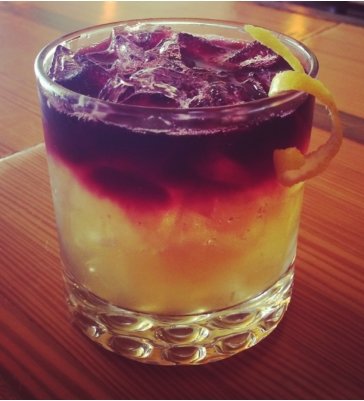
Crafting cocktails is a completely different story. This requires an advanced level of understanding of the interplay between liquors and how weight, alcohol, flavor profile and presentation can enhance — or diminish — the pleasure of a cocktail.
You can think of sommeliers like DJs, equipped with an arsenal to complement whatever situation they find themselves in. Great bartenders, on the other hand, are jazz drummers, improvising in constantly changing space, marshalling all the moving pieces to the delight of the guests.
The overlap of these two specialties is an underexplored class of beverages that offers some real gems. Wine is an underappreciated cocktail ingredient that, when deployed thoughtfully, adds fruit and flavor complexity to a drink. We’ll share a few of our favorites here, but we encourage you to experiment on your own.
The New York sour, a variation on the common whiskey sour, is a classic wine cocktail. This drink features bourbon, simple syrup and lemon juice with red wine floating on the top (we recommend Padrillos malbec) and garnished with a lemon peel. Floating the wine is an easy trick. Pour the other ingredients into a rocks glass, then make sure the glass is jam-packed with ice. Turn a spoon upside down over the glass, and pour the wine slowly over the spoon until the glass is full. Some suggest shiraz, but young, inexpensive malbec is the best choice for this drink. The core of raspberry/ blackberry/plum flavors from malbec is perfect, whereas the tannins of shiraz tend to obscure the other flavors.
At Bridge Street Social, we serve a Bridge Street 75, our take on the French 75. Traditional version of this cocktail, which is served in a wine glass, features cognac or gin, Champagne, lemon juice and sugar. We use Bilberry Black Hearts Gin from Journeyman Distillery in Three Oaks, which may be the most exciting distillery in Michigan. Its gin is organic with a wheat base, and the bilberries add a blueberry-like note to the gin. The berry notes maneuver the gin into something beyond the typical sea of juniper.
Next up, we add peach bitters, lemon juice, simple syrup, a touch of lemon juice and a tiny amount of orange juice. While the typical French 75 uses sparkling wine or Champagne, we go to one of our favorite aces-in-the-hole: Famega Vinho Verde. It’s an affordable, effortless white wine with a spritz. Vinho Verde is a must have for any bar. It’s a game changer for its dexterity, and it’s a perfect palate cleanser. We like to serve this cocktail in a wine glass with a peach slice garnish. The final result highlights the different intensities of stone and citrus fruit.
The Aperol Spritz may be one of the most famous wine-inclusive cocktails, and we have certainly seen an increase in local consumption. It’s a true hallmark Venetian aperitif and one of the easiest cocktails to make.
The recipe is simple: three parts prosecco, two parts Aperol and a splash of soda. You can serve it in a Champagne flute, rocks glass or a wine glass. If you choose to use a flute, give the Aperol a quick stir with some rocks in a cocktail shaker, because ice should stay out of the flute. But feel free to drop some ice in the rocks glass or wine glass.
Any prosecco will do, but we use Nino Franco’s Rustico for its unwavering style: freshness, light florals and subtle notes of peach. Hailing from the Italian town of Valdobbiadene, a stone’s throw from the Venetian Dolomites, Rustico can be found in stores for roughly $18. Don’t be tempted to use Campari in place of Aperol. Campari is less citrusy, has more alcohol and is drier. The drink will come off clumsy and boozy.
Lastly, do yourself a favor and start mixing red wine and cola. I know it sounds odd, but trust us here. The Spanish version, Kalimotxo has a young history — it started in the 1970s — but it will forever land a place in your drink library once you’ve tried it.
Kalimotxo and txakoli, a spritzy wine from northern Spain, are the beverages of choice in what is arguably the best food town in the world, San Sebastián, Spain. The town’s Parte Vieja (Old Town) is crammed with bars that pair these drinks with pintxo, delicious small plates comparable to tapas found in other parts of Spain. It is customary for locals to have one pintxo and a small drink at an establishment then move on to the next bar.
As for the recipe, the Kalimotxo is half cola, half red Rioja wine and always a party.
Nick Marcy is bar manager of Bridge Street Social, a wine and cocktailsfocused restaurant in DeWitt. Call him Dr. Drinks or just Nick. Justin King is co-owner and general manager of Bridge Street Social. He drinks whatever Nick puts in front of him. Either can be reached at info@bridgestreetsocial.com.
Support City Pulse - Donate Today!
Comments
No comments on this item Please log in to comment by clicking here